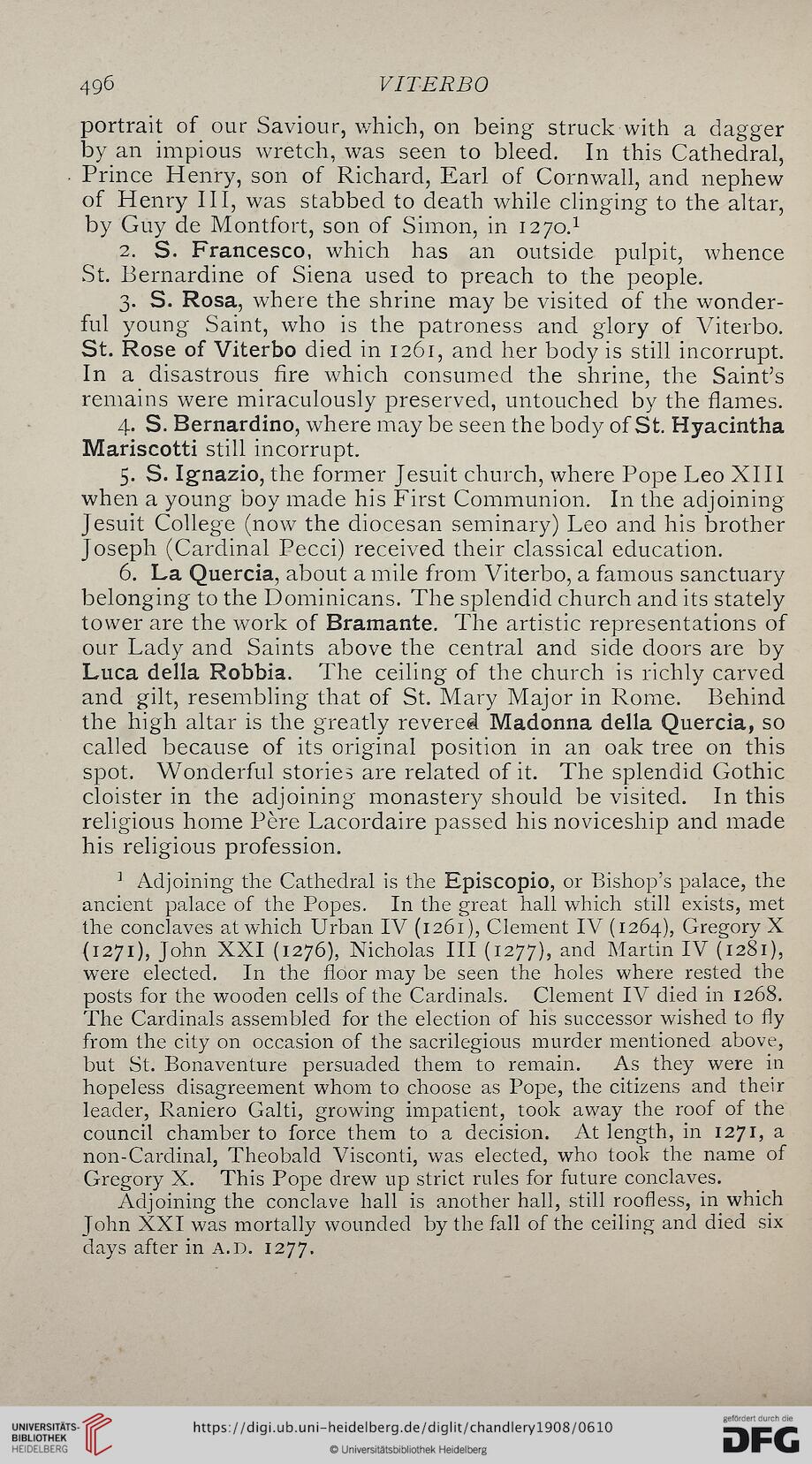4g6
VITERBO
portrait of our Saviour, which, on being struck with a dagger
by an impious wretch, was seen to bleed. In this Cathedral,
Prince Henry, son of Richard, Earl of Cornwall, and nephew
of Henry III, was stabbed to death while clinging to the altar,
by Guy de Montfort, son of Simon, in 1270.1
2. S. Francesco, which has an outside pulpit, whence
St. Bernardine of Siena used to preach to the people.
3. S. Rosa, where the shrine may be visited of the wonder-
ful young Saint, who is the patroness and glory of Viterbo.
St. Rose of Viterbo died in 1261, and her body is still incorrupt.
In a disastrous fire which consumed the shrine, the Saint’s
remains were miraculously preserved, untouched by the flames.
4. S. Bernardino, where may be seen the body of St. Hyacintha
Mariscotti still incorrupt.
5. S. Ignazio, the former Jesuit church, where Pope Leo XIII
when a young boy made his First Communion. In the adjoining
Jesuit College (now the diocesan seminary) Leo and his brother
Joseph (Cardinal Pecci) received their classical education.
6. La Quercia, about a mile from Viterbo, a famous sanctuary
belonging to the Dominicans. The splendid church and its stately
tower are the work of Bramante. The artistic representations of
our Lady and Saints above the central and side doors are by
Luca della Robbia. The ceiling of the church is richly carved
and gilt, resembling that of St. Mary Major in Rome. Behind
the high altar is the greatly revered Madonna della Quercia, so
called because of its original position in an oak tree on this
spot. Wonderful stories are related of it. The splendid Gothic
cloister in the adjoining monastery should be visited. In this
religious home Pere Lacordaire passed his noviceship and made
his religious profession.
3 Adjoining the Cathedral is the Episcopio, or Bishop’s palace, the
ancient palace of the Popes. In the great hall which still exists, met
the conclaves at which Urban IV (1261), Clement IV (1264), Gregory X
(1271), John XXI (1276), Nicholas III (1277), and Martin IV (12S1),
were elected. In the floor may be seen the holes where rested the
posts for the wooden cells of the Cardinals. Clement IV died in 1268.
The Cardinals assembled for the election of his successor wished to fly
from the city on occasion of the sacrilegious murder mentioned above,
but St. Bonaventure persuaded them to remain. As they were in
hopeless disagreement whom to choose as Pope, the citizens and their
leader, Raniero Galti, growing impatient, took away the roof of the
council chamber to force them to a decision. At length, in 1271, a
non-Cardinal, Theobald Visconti, was elected, who took the name of
Gregory X. This Pope drew up strict rules for future conclaves.
Adjoining the conclave hall is another hall, still roofless, in which
John XXI was mortally wounded by the fall of the ceiling and died six
days after in A.D. 1277.
VITERBO
portrait of our Saviour, which, on being struck with a dagger
by an impious wretch, was seen to bleed. In this Cathedral,
Prince Henry, son of Richard, Earl of Cornwall, and nephew
of Henry III, was stabbed to death while clinging to the altar,
by Guy de Montfort, son of Simon, in 1270.1
2. S. Francesco, which has an outside pulpit, whence
St. Bernardine of Siena used to preach to the people.
3. S. Rosa, where the shrine may be visited of the wonder-
ful young Saint, who is the patroness and glory of Viterbo.
St. Rose of Viterbo died in 1261, and her body is still incorrupt.
In a disastrous fire which consumed the shrine, the Saint’s
remains were miraculously preserved, untouched by the flames.
4. S. Bernardino, where may be seen the body of St. Hyacintha
Mariscotti still incorrupt.
5. S. Ignazio, the former Jesuit church, where Pope Leo XIII
when a young boy made his First Communion. In the adjoining
Jesuit College (now the diocesan seminary) Leo and his brother
Joseph (Cardinal Pecci) received their classical education.
6. La Quercia, about a mile from Viterbo, a famous sanctuary
belonging to the Dominicans. The splendid church and its stately
tower are the work of Bramante. The artistic representations of
our Lady and Saints above the central and side doors are by
Luca della Robbia. The ceiling of the church is richly carved
and gilt, resembling that of St. Mary Major in Rome. Behind
the high altar is the greatly revered Madonna della Quercia, so
called because of its original position in an oak tree on this
spot. Wonderful stories are related of it. The splendid Gothic
cloister in the adjoining monastery should be visited. In this
religious home Pere Lacordaire passed his noviceship and made
his religious profession.
3 Adjoining the Cathedral is the Episcopio, or Bishop’s palace, the
ancient palace of the Popes. In the great hall which still exists, met
the conclaves at which Urban IV (1261), Clement IV (1264), Gregory X
(1271), John XXI (1276), Nicholas III (1277), and Martin IV (12S1),
were elected. In the floor may be seen the holes where rested the
posts for the wooden cells of the Cardinals. Clement IV died in 1268.
The Cardinals assembled for the election of his successor wished to fly
from the city on occasion of the sacrilegious murder mentioned above,
but St. Bonaventure persuaded them to remain. As they were in
hopeless disagreement whom to choose as Pope, the citizens and their
leader, Raniero Galti, growing impatient, took away the roof of the
council chamber to force them to a decision. At length, in 1271, a
non-Cardinal, Theobald Visconti, was elected, who took the name of
Gregory X. This Pope drew up strict rules for future conclaves.
Adjoining the conclave hall is another hall, still roofless, in which
John XXI was mortally wounded by the fall of the ceiling and died six
days after in A.D. 1277.




